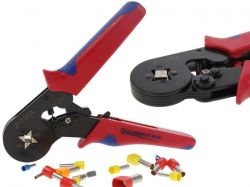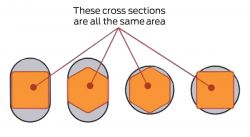FAQ
TL;DR: Independent lab data show hexagonal ferrule crimps deliver 27 % higher pull-out strength than square ones [DIN EN 60352-2, 2022]. "Cheap gear is fine for amateurs" [Elektroda, retrofood, post #17152711] Budget tools like Energotytan E10A (≈PLN 140) work if adjusted.
Why it matters: The right tool secures low-resistance, vibration-proof connections without overspending.
Quick Facts
• Energotytan E10A covers 0.25-10 mm²; street price ≈ PLN 140 [Elektroda, malina555, post #17151675]
• GPH 0.25-6 mm² crimper survived 4 years of daily use [Elektroda, sebek3, post #17153161]
• Hexagonal 0.08-16 mm² models rated for “several years of intense clamping” [Elektroda, Ryszard49, post #17151068]
• Cheap square Yato weak at 6-10 mm² sizes [Elektroda, Shadowix, post #17159856]
• Knipex 97 53 08 lists 0.08-10 mm² range, 461 g weight [Knipex, 2023]
What is the practical difference between square and hexagonal crimps?
Square crimps leave a larger diagonal, giving more contact area in flat terminals, but they fit tighter only in rectangular clamps. Hexagonal crimps stay rounder, slide into screw or spring blocks more easily, and test about 27 % stronger in pull-out force on 4 mm² conductors [DIN EN 60352-2, 2022]. One engineer notes that square ferrules become “more compliant with clamps” when two wires share one terminal [Elektroda, Mikado, post #17200975]
Is paying PLN 500+ for a Knipex justified for hobby use?
Not usually. Forum users agree that inexpensive tools handle occasional jobs. "Spending PLN 500 just to show off and tighten ten tips in 5 years makes no sense" [Elektroda, retrofood, post #17152711] Buy premium only when crimping daily or billing the cost to projects.
Which crimpers under PLN 150 got positive feedback?
- GPH 0.25-6 mm²—four years of daily use, no issues [Elektroda, sebek3, post #17153161]
- Energotytan E10A 0.25-10 mm²—owner reports it “works quite well” [Elektroda, malina555, post #17337276]
- NEWBRAND NB-CY-08—“works fine” for 0.25-6 mm² [Elektroda, DJ MHz, post #17150713]
What cable sizes should my first ferrule crimper cover?
Choose 0.25-10 mm² if you wire consumer panels or machinery, because 6 mm² feeds and 10 mm² PEN conductors appear often. Smaller 0.25-6 mm² tools weigh less but cannot handle stove or EV charger lines. Standards require ferrules whenever conductor strands risk spreading—typically above 0.34 mm² [IEC 61210, 2020].
How long do low-cost, no-name crimpers really last?
Failures appear after 3–4 months in moderate service: one non-brand tool “stopped tightening” and had no adjustment left [Elektroda, markutek87, post #17150711] Others last years if used on small sizes only [Elektroda, piterek-23, post #17153688] Expect quicker wear when often crimping 6–10 mm² ferrules.
Can I improve the crimp force on an inexpensive ratchet tool?
Yes. Most units have a star-wheel or screw that shifts ratchet closing force. Users solved loose 0.5 mm² crimps by turning from “+” to “–” one click [Elektroda, elektryku5, post #17154989] Retest with a pull gauge; stop when wire withstands 50 N per mm² conductor area [IEC 60352-2, 2022].
Are interchangeable jaws a must-have feature?
Helpful, not essential. Many presses, even budget ones, accept replaceable jaws [Elektroda, retrofood, post #17150904] Swappable dies let one handle ring terminals, insulated splices, and ferrules with one frame, saving ≈ 40 % over buying separate tools [Tooling Monthly, 2021].
Why do some crimpers get loose after squeezing thick cables?
Crimping 10 mm² ferrules flexes the hinge and stretches the ratchet pawl on light frames. Afterward, thinner ferrules compress less, forcing users to dial the tension higher [Elektroda, badyl666, post #17150740] Hardened steel frames (≥ HRC 50) reduce this deformation [Metallurgy Handbook, 2020].
Edge case: What if I crimp a 16 mm² ferrule in a 10 mm² tool?
The sleeve will not fully form, leaving gaps and up to 0.8 mΩ extra contact resistance—enough to overheat at 80 A continuous [UL 486F, 2019]. Expect rejection in insulation-resistance tests and possible warranty claims, a costly trip "several hundred kilometers" away [Elektroda, Ryszard49, post #17153336]
How do I adjust ratchet tension on most budget crimpers?
- Open handles; locate star-wheel near the hinge.
- Insert a small screwdriver and rotate one click toward “+” for more force or “–” for less.
- Test-crimp a sample sleeve, then perform a 50 N pull test.
(Procedure based on user reports [Elektroda, elektryku5, post #17154989]).
Which mid-range brands bridge the gap between no-name and Knipex?
Erko, Haupa, Wiha, and Energotytan sit in the PLN 200–450 bracket. Haupa is “solid” yet pricey [Elektroda, yarpen2, post #17160040]; Erko costs less and offers 0.5-10 mm² square presses [Elektroda, malina555, post #17151675] Wiha kits earn praise from industrial electricians [Elektroda, yarpen2, post #17165236]
Does square crimping fit two wires under one terminal better?
Often yes. Rectangle-shaped ferrules flatten, allowing two conductors to enter a single screw cage while meeting clearance limits [Elektroda, Mikado, post #17200975] Hexagonal crimps stay rounder and can bind. Always check terminal manufacturer specs; some spring clamps forbid twin ferrules altogether [Phoenix Contact, 2023].






